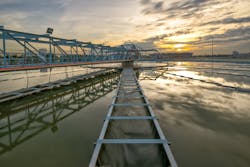The digitalization in water industry improvements is a much-discussed topic that changes how professionals in the sector work and meet organizational goals. The Internet of Things (IoT) has been a significant driver of digital water treatment adoption, particularly since people now have plenty of options for implementing the technology in industrial water plants. Here are some exciting examples of what digitization means for individuals who work in water treatment facilities.
Better Data Collection Made Possible By Digital Water Treatment Technology
Before the days of connected water technologies, people primarily used experience, product instructions and guesswork to determine chemical dosages and other specifics associated with water treatment. However, that often meant people didn’t know when things went wrong until it was too late to fix them.
The digitalization in water industry processes massively changes things. Now, smart sensors can collect and send real-time data that confirms precisely what’s happening within a plant at any given moment. Such information provides vital confirmation that everything is as it should be.
Additionally, the increased access to information shapes and speeds decision-making, helping leaders feel more confident in their actions. The United States loses trillions of dollars in treated water yearly due to infrastructure failures and other shortcomings. Such issues often happen because people lack the relevant information to take quick action. Since water treatment is increasingly digitized, people are more likely to have the information they need at their fingertips.
Most digital platforms in the water treatment industry deliver data directly to a person’s smartphone or another internet-enabled device. They can then review it and make relevant choices, even if they are not at the plant.
The Toledo Water Treatment Plant uses a real-time optical sensor to measure water from Lake Erie every 15 minutes. The goal is to check whether the cyanobacteria that make harmful algal blooms are starting to break open and release toxins. If it is, the water treatment plant will face more challenges in removing the dissolved bacteria.
Data-based platforms also let people set parameters and get immediate alerts if statistics fall outside those ranges. It’s then doubtful problems will persist for too long unless they happen due to internal organizational issues rather than a lack of information.
Money-Saving Opportunities Unlocked With Digitalization in Water Industry Processes
Advancements in digital water treatment also help organizations save money, increasing the chances they’ll remain profitable in a competitive market. The push for more digitization has impacted the water industry outside of treatment processes, too.
Consider how the city of Myrtle Beach, South Carolina was an early adopter of smart water meters. Decision-makers there initially adopted the technology in 2015 to launch a four to five-year plan that benefitted 21,000 water utility customers. That change enabled the usage of a radio-read system for improved monitoring at the company level. Similarly, customers could track their water usage for better visibility.
This setup removed the need for manual meter reads. Components of the system also detected leaks. Thus, company leaders did not have to spend money on physical meter-reading methods. They could also get real-time alerts of issues such as burst pipes, allowing them to deploy the necessary resources to mitigate problems speedily.
Options like these give companies quick money-saving wins and allow them to cut costs over time by opting for improved processes. Indeed, pursuing digitalization in water industry tasks requires time, effort and money. Yet, leaders need to think about how digital technologies can help them address weaknesses and meet goals. When a German city adopted digitization for water treatment monitoring, those overseeing quality saw information fed to a centralized dashboard. The outcome meant people could make fewer physical plant visits.
Process digitalization can also eliminate manual tasks, which saves money and reduces error rates. Water testing is a major part of successful treatment because people must verify that the methods used got the intended results. Some products on the market include color-based components that change as a test reaches progressively later stages. When people get test outcomes, they can capture data digitally rather than relying on pen-and-paper methods that are comparably time-consuming and less accurate.
Letting Digital Noses Handle Stench Tests
Digitization also enabled upgrades for dynamic olfactometry, where a human sniffs bags of air collected from a wastewater treatment plant. The process costs a lot and is too time-consuming to allow people to react quickly and deal with the root cause of unexpected odors.
To combat this, researchers developed an electronic nose that works with artificial intelligence. It performs almost as well as human noses. They attached it to a drone and sent it to a wastewater treatment plant in southern Spain. It takes in air with a 33-foot tube and analyzes it in a sensor chamber. Field tests showed that the electronic nose performed comparably to humans in 10 of 13 trials.
Digital Twins Give Unparalleled Water Treatment Visibility
It’s becoming more popular for leaders in many industries to use digital twins. This approach gives digitized and highly accurate copies of real-life assets. So, a decision-maker might have a digital twin built that shows a portion of the water treatment process or an extremely detailed digitized version of a particular machine used in the water treatment plant.
Digital twins also support risk mitigation. Imagine if a water company’s leadership team ran a disaster-centered scenario in a digital twin and used what they learned from the exercise to guide their emergency response planning. Such digitalization in water industry efforts aids preparedness and helps people uncover any problems in their plans before a real-life catastrophe tests them.
Leaders often find it easier to anticipate facility expansions and other infrastructural changes. Similarly, when planning water treatment plant remodeling, a digital twin enables users to see the effects of specific changes before approving the associated budgets. Planning things like safe traffic flow through a facility becomes more manageable, too. How would things become better or worse if the building had an entrance at one place versus another? Digital twins can answer this question and others.
A Project Shows the Real-Life Options for Water Treatment and Digital Twins
A European Union-funded project called Digital-Water City explored various possibilities for using digital twins in the wastewater treatment sector. In one real-life application, people at an Italian facility utilized digital twins to oversee the safe reuse of water for the agriculture sector. More specifically, the digital twins help monitor water chemistry and pathogen levels.
The solution also relies on machine learning to spot outliers and provide new insights. This additional information helps fill gaps in existing water quality databases at the company. Another handy thing about digital twins in the water treatment sector and elsewhere is they let people in the business simulate particular scenarios. Then, people can make digital tweaks to determine the effects of real-life changes to a system before carrying them out. Thus, they’re more likely to have successful outcomes and save money.
Before utilizing digital twins in water treatment plants, people in positions of authority should think about some specifics to make their projects as successful as possible. What do they want to track with the digital twin? What’s their estimated budget and timeframe for this initiative? Have they chosen a service provider for the digital twin technology? It’s best to iron such things out before getting too deep into the planning phase. Otherwise, people could run into preventable pitfalls.
Digitalization Supports Trouble-Free Operations
People often pursue digital upgrades to their workflows to prevent costly and time-consuming scenarios. Consider how many fleet managers use vehicle telematics to get vehicle health details. People working in water treatment facilities can do something similar by installing IoT sensors on critical equipment.
Those components often track things like vibration, temperature and the number of operating minutes per day. People then get immediate warnings of anything out of the ordinary, often saving companies money. It allows them to move away from other methods that may mean equipment gets serviced before it truly needs it or when it’s already too late to mitigate a massive problem.
Some companies still use reactive maintenance strategies, only fixing equipment once problems are already apparent. However, doing so can lead to decreased reliability and optimization. Plus, a reactive approach could make it more likely that companies using it will need to pay for significant repairs or even equipment replacements.
On the other hand, more proactive strategies made possible by progress in digital water treatment tend to save businesses money. That’s because they allow technicians to spot abnormal machine performance statistics sooner. When people become aware of issues more quickly, it’s more likely that whatever’s wrong will be a faster and less expensive fix.
During the pandemic, some water treatment facilities deployed sensors on sewage pumps to detect backups. They did this in response to a behavioral change during the COVID-19 pandemic, where more people flushed disinfectant wipes and caused obstructions. The sensors learned and examined vibrational patterns, then sent alerts of abnormalities.
Deploying a more innovative maintenance strategy doesn’t necessarily mean putting connected sensors on every piece of equipment in a water treatment facility. Many leaders lack the budgets for such extensive usage and want to see payoffs before starting to scale. However, a good starting point is prioritizing the most expensive or essential equipment. The assets in that group are the most likely to give leaders the highest return on investment.
Digital Upgrades Help the Water Industry Succeed
This overview highlights numerous ways to apply digital water treatment upgrades in a facility. When decision-makers think about their specific challenges and weaknesses and how digitalization can support them, they’ll be more likely to enjoy successful outcomes.
Emily Newton | Editor -in-chief
Emily Newton is editor-in-chief of Revolutionized. Newton can be reached at [email protected].






